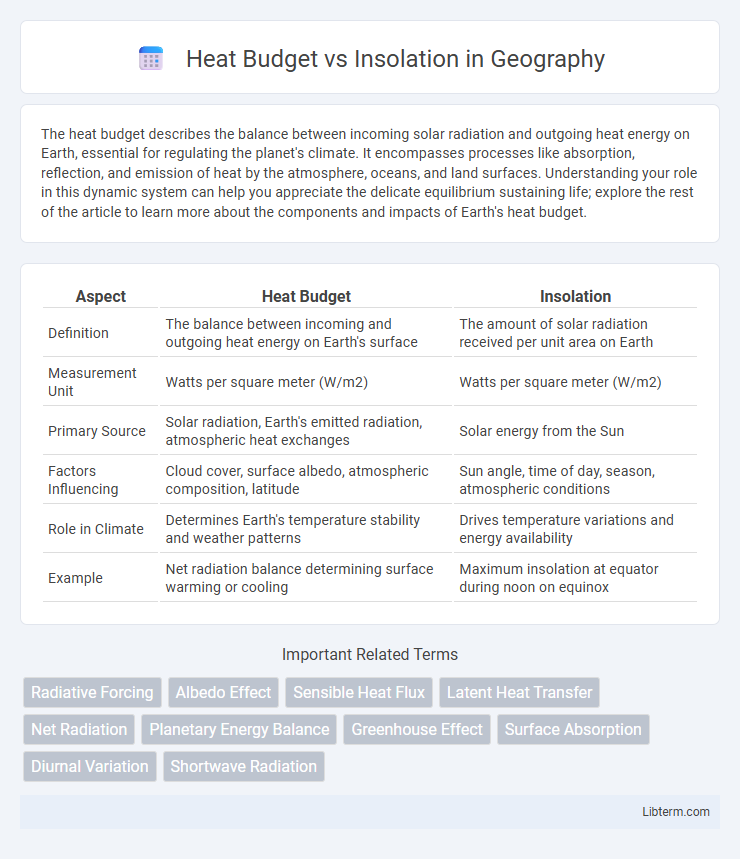The heat budget describes the balance between incoming solar radiation and outgoing heat energy on Earth, essential for regulating the planet's climate. It encompasses processes like absorption, reflection, and emission of heat by the atmosphere, oceans, and land surfaces. Understanding your role in this dynamic system can help you appreciate the delicate equilibrium sustaining life; explore the rest of the article to learn more about the components and impacts of Earth's heat budget.
Table of Comparison
| Aspect | Heat Budget | Insolation |
|---|---|---|
| Definition | The balance between incoming and outgoing heat energy on Earth's surface | The amount of solar radiation received per unit area on Earth |
| Measurement Unit | Watts per square meter (W/m2) | Watts per square meter (W/m2) |
| Primary Source | Solar radiation, Earth's emitted radiation, atmospheric heat exchanges | Solar energy from the Sun |
| Factors Influencing | Cloud cover, surface albedo, atmospheric composition, latitude | Sun angle, time of day, season, atmospheric conditions |
| Role in Climate | Determines Earth's temperature stability and weather patterns | Drives temperature variations and energy availability |
| Example | Net radiation balance determining surface warming or cooling | Maximum insolation at equator during noon on equinox |
Introduction to Heat Budget and Insolation
Heat budget refers to the balance between incoming solar radiation and outgoing terrestrial radiation that regulates Earth's temperature. Insolation, or incoming solar radiation, is the primary energy source driving the heat budget by delivering solar energy to Earth's surface. Understanding the dynamics between heat budget and insolation is essential for analyzing climate patterns and energy exchanges within the atmosphere.
Defining Heat Budget: Components and Importance
The heat budget refers to the balance between incoming solar radiation (insolation) and outgoing terrestrial radiation that regulates Earth's temperature. Key components include absorbed solar energy, reflected radiation by clouds and surface albedo, and emitted infrared radiation from Earth's surface and atmosphere. Understanding the heat budget is crucial for climate modeling, predicting temperature changes, and assessing energy exchanges within Earth's system.
Understanding Insolation: Factors and Measurement
Insolation, or incoming solar radiation, varies due to factors such as solar angle, atmospheric composition, and surface albedo, directly impacting Earth's heat budget. Measurement techniques include pyranometers and satellite sensors, which quantify solar energy absorbed and reflected by the Earth's surface. Accurate insolation data is crucial for modeling climate dynamics and energy balance within the heat budget framework.
Key Differences Between Heat Budget and Insolation
Heat budget refers to the balance between incoming solar radiation absorbed by the Earth and the outgoing terrestrial radiation emitted back into space, determining the planet's overall temperature stability. Insolation specifically measures the amount of solar radiation received per unit area on the Earth's surface, varying with latitude, time of day, and atmospheric conditions. The key difference lies in that insolation represents input energy, while heat budget encompasses the entire energy flow, including absorption, reflection, and emission processes.
The Role of Insolation in Earth’s Heat Budget
Insolation, the incoming solar radiation received by Earth, acts as the primary energy source driving the planet's heat budget by providing the essential radiation that heats the surface and atmosphere. The balance between absorbed insolation and emitted infrared radiation governs Earth's temperature equilibrium, with variations in solar intensity, angle, and duration influencing regional and global climate patterns. Clouds, surface albedo, and atmospheric composition modulate how much insolation is absorbed or reflected, directly impacting the heat budget and overall climate system dynamics.
Factors Affecting Heat Budget and Insolation
Heat budget depends on factors such as solar angle, surface albedo, atmospheric composition, cloud cover, and latitude, which influence energy absorption and reflection. Insolation varies with the Earth's tilt, distance from the sun, and seasonal changes, determining the intensity and duration of solar radiation received. Both heat budget and insolation are interconnected through these variables, affecting global temperature patterns and climate dynamics.
Geographic Variability of Insolation and Heat Budget
Geographic variability of insolation significantly influences the Earth's heat budget, as regions near the equator receive higher solar radiation compared to polar areas, leading to uneven heating. Tropical zones experience intense and consistent insolation, driving powerful energy absorption and heat retention, while polar regions show reduced insolation resulting in lower heat accumulation. This geographic disparity in solar input affects atmospheric circulation and surface temperature patterns, playing a critical role in the global climate system.
Impacts of Heat Budget and Insolation on Climate
The heat budget, representing the balance between incoming and outgoing energy, directly influences global temperature patterns and climate stability. Insolation, the solar radiation received by Earth, drives atmospheric circulation and seasonal weather variations by determining the amount of energy absorbed at different latitudes. Variations in heat budget and insolation affect climate phenomena such as glaciers' melting rates, drought frequency, and the intensity of weather extremes.
Human Influence on Heat Budget and Insolation
Human activities significantly alter the Earth's heat budget by increasing greenhouse gas concentrations, which trap heat and reduce outgoing longwave radiation, leading to global warming. Urbanization and land-use changes increase surface albedo variations, affecting the balance of incoming solar radiation (insolation) absorbed by the Earth's surface. The enhanced greenhouse effect combined with altered insolation patterns disrupts natural energy flows, intensifying climate change and impacting weather systems globally.
Conclusion: Integrating Heat Budget and Insolation Insights
Integrating heat budget and insolation insights reveals how Earth's energy balance governs climate dynamics by quantifying incoming solar radiation and outgoing terrestrial heat. Accurate assessment of insolation variations alongside heat budget components like albedo and greenhouse gas effects enables precise modeling of temperature fluctuations and energy distribution. This holistic understanding is crucial for predicting climate change impacts and developing effective mitigation strategies.
Heat Budget Infographic

 libterm.com
libterm.com